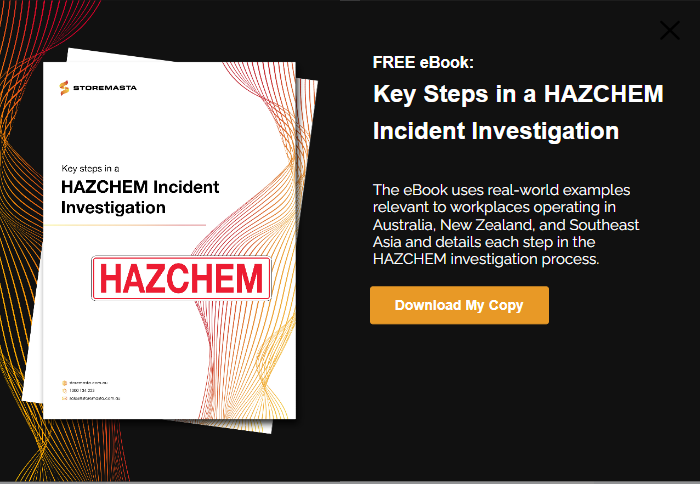Interviewing witnesses can be the most challenging part of a HAZCHEM incident investigation. Incidents involving hazardous chemicals can be fatal, cause debilitating injuries, and lead to destruction of property or the environment. Workers directly involved in the incident (as well as any witnesses) will likely be suffering emotional stress — and may be hesitant to talk about what happened. This blog focuses on interviewing witness, offering tips on how to run the witness interviews to gain as much accurate and helpful detail about the event as possible.
Deciding Who to Interview
Anyone involved in an alleged incident should complete and submit an incident report as soon as possible after the incident. This includes injured workers, witnesses and anyone else involved in the event. Your workplace should already have an official procedure (and form) for incident reporting which requests the following information (as a minimum):
- Date, time, and location of the incident
- Description of what happened
- Tasks being completed before and during the incident
- Names of people involved or present at the time
- Where everyone (including witness) was standing/located during the incident
- Details of chemicals and substances
- Details of injuries, first aid treatment and medical care
These incident reports play an essential part in your investigation and will help you determine who needs to be interviewed. Incident reports may uncover people like delivery drivers or customers who were present at the time.

The interviews will form your incident report, and should assist with formulating corrective actions to ensure the ihazardous chemical ncident does not occur again.
Organising The Interview
Arrange to interview each person alone and in a neutral environment. As much as possible separate workers during the interview process so they don’t start to create a collaborated story. This isn’t always a deliberate effort to hide the truth, sometimes when there are gaps in a person’s understanding of an incident their recollection may be influenced by someone else (especially a supervisor).
For example: a worker is sprayed with caustic chemicals and later dies from their injuries. Three workers were present in the work area at the time of the incident, and you want to establish if the worker performed their pre-operational safety checks. Two of the workers definitely saw the safety checks performed but the other worker was not in a position to verify if the actions took place. If these workers begin to talk among themselves the third worker may begin to adopt their story into their own testimony.
When Should Witnesses Be Interviewed?
It’s always best to conduct witness interviews as soon as possible after an incident. This will ensure that their recollections of events (and events leading up to the incident) are fresh in their mind. This will make the investigation process more effective, with the likelihood of detailed information being more accurate and detailed if the parties involved are interviewed shortly after the incident.
However, if the investigation has been triggered from a review of incident reports, sometimes many months may have passed since the incident occurred. Interview witnesses as soon as possible so that you can work on collating correct and helpful information that will help you make the necessary changes to control future chemical risk.
Work Safe offers information on how to prepare and conduct witness interviews and your workplace investigations.
Some key tips for the workplace investigation include:
- Collating information as quickly as possible after the incident
- Not bringing bias into the investigation or the witness interviews
- Visiting the scene of the incident before any physical evidence is disturbed
- Keeping the scene intact; ensuring nothing has been moved
- Taking photographs and/or video footage of the scene
Conducting The Interview
When conducting the interview remember that some workers may be suffering from PTSD (post-traumatic stress disorder) if someone was seriously harmed or killed in the incident. Be compassionate and respectful, reassure the witness that their testimony will help determine the cause of the incident and assist in the implementation of additional safety measures.
Before beginning the questioning, you should inform the witness how the interview will be recorded and who will have access to their responses. Introduce the interview panel and briefly explain their roles, assuring staff that confidentiality will be maintained during the witness interviews.
This is also the time to remind the parties involved with the investigation of their legal responsibility to give accurate testimony.

Make sure your staff understand that the interview will be recorded and who will have access to the information.
Questioning Witnesses
When interviewing witnesses use questions that allow people to give detailed responses, and especially avoid narrow questions that trigger ‘yes’ or ‘no’ responses. For example, a question like: Was your co-worker wearing chemical resistant goggles before using the acid? is too narrow, ask instead What PPE was your co-worker wearing before using the acid?
Once you have asked a question in your hazardous chemical incident investigation, give the witness time to answer each question in full.
Listen carefully during the witness interviews — and allow silences. Sometimes that silence triggers the witness to add more details.
Investigation Questions For Witnesses
Determining the questions for your witnesses can assist in collecting the right information for your organisation.
Incident investigation interview questions must focus on the who, what, when, where, how and why of the situation.
With regards to an incident that involves hazardous chemicals, your interview questions for witnesses may include:
- Who was involved?
- Who has information about events leading up to the incident?
- What tools/equipment was being used?
- What safety rules may have been violated?
- When was an explanation of the hazards given to parties involved?
- When was something wrong noticed by staff?
- When did the incident happen?
- When was emergency decontamination equipment or first aid used?
- Was a supervisor present?
- Why did communication fail?
- Where were the witnesses at the time of the event?
- Where were supervisors?
- How did the incident occur?
- How was the injury sustained?
- How could the event have been avoided?
Obtaining Answers to Assist with Chemical Investigation
Frame your questions so you can find out:
- What systems of work were being carried out and what instructions had been given.
- If there was any variation from standard procedures, and if so why.
- What chemicals were being used or handled.
- Details about PPE: was it used, what condition was it in, did it fail.
- Location of relevant people (co-workers, supervisors, bystanders) and their involvement in the incident.
- Workplace conditions (lighting, warning signs, weather, floor surfaces, housekeeping, noise, presence of fumes/vapours).
- First aid and emergency responses (were safety showers used, was emergency equipment available and operational, who reported the incident).
At the end of the interview, you can ask the witness for their opinion on what may have caused the incident. Remain impartial during their response, you want to record their testimony to establish facts not jump to conclusions.
IMPORTANT: During the interview you might take the witness back to the scene of the incident to re-enact what happened in slow motion. If you do, make sure you aren’t creating another safety hazard when you ask a worker to replicate a task.
Key Steps in a Workplace Investigation
The investigation process involves many considerations from interviewing the parties involved to ensuring that all evidence is accurately noted and recorded. If you’d like a more detailed guide to running an efficient investigation process, we recommend downloading our free eBook Key Steps in a HAZCHEM Incident Investigation. It’s a clear, easy-to-read text and uses real-world examples relevant to workplaces in any industry. Access your copy today to learn more about the investigation process for hazardous chemical incidents.
Joining the team as a Dangerous Goods Storage Consultant, Melissa Hampton became Storemasta's Marketing Manager in late 2021. With extensive knowledge and experience in chemical compliance, Melissa is responsible for leading the Marketing team and helping shape their marketing strategy. In her spare time, you can find Melissa hiking, swimming and enjoying the great outdoors in beautiful north-west Tasmania.
